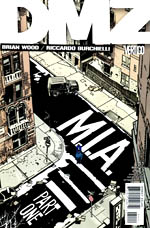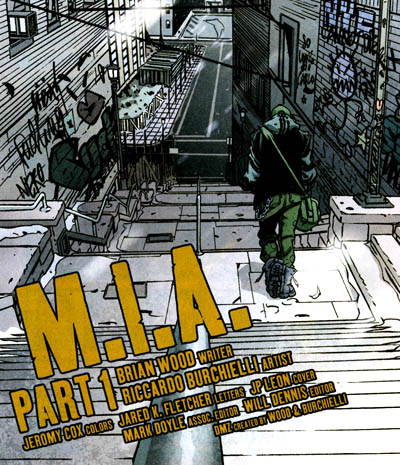 Written by Brian Wood
Written by Brian Wood
Art by Riccardo Burchielli
32 pages, color
Published by Vertigo/DC Comics
One of the many things that I appreciate about Brian Wood and Riccardo Burchielli’s DMZ is that it never seems to stay complacent, or even in one place for very long. It’s easy to see how it could have been that way; Manhattan turned into the demilitarized zone in the heart of a new American Civil War is full of endless story possibilities, and even last month’s special one-off DMZ #50 reminded readers of that via a series of glimpses of life across the island. But with the events of DMZ #49 still weighing heavily over the series, it’s refreshing to see Wood following through in brutal honesty.
When a nuclear explosion occurs just up the river from your titular setting, it would be cheating to not have this be a game-changing events. Sure enough, Wood delivers just that. The Delgado regime is being blamed, the senior staff are all wanted criminals, and Matty Roth is hiding out in Washington Heights while dealing with his own particular demons. Roth’s part in the deaths of innocents two months ago was a moment that would be hard to ignore at best, and the specter of that decision still hangs over the comic. It’s a hard mixture of anger and self-pity, and while it’s not a Matty Roth you’d want to read about forever, it’s easy to see that this is a turning point for our protagonist. "M.I.A." looks to be a crucible of sorts, perhaps casting Roth into a new man.
 At the same time, it’s hard for Wood to entirely give up the travelogue nature of DMZ, and I’m glad he’s never done so. I think this is the first time we’ve seen Washington Heights, up at the northern tip of Manhattan. The closest location within the DMZ to where the nuclear explosion occurred at Indian Point, it makes sense that this neighborhood would be more deserted than most places we’ve seen so far. It’s a good location for Roth to be, leaving him primarily alone to start working through all of his issues about what went down over the last storyline. Of course, even when other people do show up, death makes another appearance and reminds Roth that no matter how hard he tries to hide within the DMZ, he can’t escape what just happened.
At the same time, it’s hard for Wood to entirely give up the travelogue nature of DMZ, and I’m glad he’s never done so. I think this is the first time we’ve seen Washington Heights, up at the northern tip of Manhattan. The closest location within the DMZ to where the nuclear explosion occurred at Indian Point, it makes sense that this neighborhood would be more deserted than most places we’ve seen so far. It’s a good location for Roth to be, leaving him primarily alone to start working through all of his issues about what went down over the last storyline. Of course, even when other people do show up, death makes another appearance and reminds Roth that no matter how hard he tries to hide within the DMZ, he can’t escape what just happened.
This is actually probably some of my favorite art from Burchielli, because the deserted streets and buildings of Washington Heights give him and colorist Jeromy Cox the chance to bring out their stark beauty and desolation. When we get the early shot of Roth walking along an empty set of stairs, Roth seems to fade into the background even as he’s in the front of the scene. His head and shoulders hang low, the greens of his outfit hidden by the dull colors of the brick wall near him. Meanwhile, the street and stairs stretch open as wide and empty as can be; Roth has the whole area to himself and he’s still skirting towards the edges. Likewise, Roth sitting all alone in an abandoned diner works well because of the composition; the broken window, the cords dangling from the drop ceiling, the abandoned food containers sitting on the countertop while Roth himself is all the way in the back. He’s almost a dot, hunched over, trying to blend into the emptiness as best he can.
This issue also has some of the most disturbing death scenes to date, switching from one extreme to the other. In one case, an IED transforms a person from alive and well to just a splatter of blood and a plume of smoke. The fan of blood on the ground, with its dull red color, just looks disturbing as Roth sees it from up above. And then, shortly thereafter, a panicked resident kills himself, the panel turning to black and white save for the blood from the exit wound. While the other death had the red surrounded by blues and grays, here it’s even harder to avoid, the red pulsing out at the reader from the stark white background. DMZ isn’t for the faint of heart, but Burchielli and Cox aren’t flinching away from a serious and deliberately disturbing subject matter.
DMZ cracking the 50-issue mark last month was a pleasant surprise, but in general I have to say it’s been a pleasure to have the book still running. This is definitely a series that builds towards each of its changes and events along the way, and this position is no exception. With an eighth collection (going as far as #49) out later this year, it’s easy to catch up with if you’ve fallen behind. With armed forces overseas as well as civil protests at home, DMZ continues to be a relevant and slightly disturbing series. Definitely take a look if you haven’t done so already.
Purchase Links: Amazon.com | Powell’s Books
